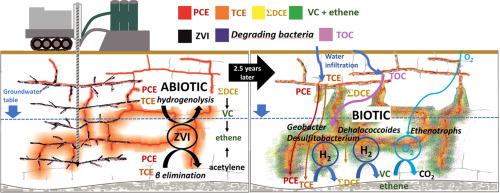Journal of Hazardous Materials ( IF 13.6 ) Pub Date : 2021-04-16 , DOI: 10.1016/j.jhazmat.2021.125883 Ondřej Lhotský 1 , Jan Kukačka 2 , Jan Slunský 3 , Kristýna Marková 4 , Jan Němeček 4 , Vladislav Knytl 1 , Tomáš Cajthaml 5

|
A low-permeability locality with heterogeneous geology contaminated primarily by tetrachloroethene (PCE) present partially in the free phase in the unsaturated zone was treated on a pilot scale via direct push pneumatic fracturing combined with the hydraulic delivery of a remediation suspension consisting of milled iron, sulphidated nanosized zerovalent iron and sand in guar gum solution. Afterwards, a whey solution was injected into the fractures as a carbon source for bacteria. The unsaturated and saturated zones were treated. Long-term monitoring of the groundwater revealed that the abiotic reduction of PCE and trichloroethene was the dominant remediation processes for several months after the injections. A complex microbial consortium was developed that was capable of effective, long-term chlorinated ethenes (ClE) dechlorination. The consortium consisted mainly of Dehalococcoides but also of other anaerobic bacterial strains capable of partial dechlorination of ClE, including the sulphate-reducing bacteria; Geobacter and Desulfitobacterium. The average chlorine number in the groundwater decreased from 3.65 to 1.38 within 2.5 years after the injections, while the average ClE concentration increased from 13.5 to 31.5 mg L-1 because of the substantial acceleration of the ClE mass-transfer to the groundwater caused by the treatment. The remediation processes remained fully active for 2.5 years.
中文翻译:

水力/气压致裂修复(FRAC-IN)在受氯化乙烯污染的现场的效果:一个案例研究
通过直接推动气动压裂结合水力输送由研磨铁组成的修复悬浮液,在中试规模上处理了低渗透率局部性低的局部性,该局部性主要由不饱和区的自由相中部分存在的四氯乙烯(PCE)污染的异质地质。瓜尔胶溶液中硫化的纳米级零价铁和沙子。之后,将乳清溶液注入骨折处,作为细菌的碳源。处理了不饱和区和饱和区。对地下水的长期监测表明,注射后的几个月中,PCE和三氯乙烯的非生物还原是主要的修复过程。建立了能够有效,长期进行氯化乙烯(ClE)脱氯的复杂微生物联合体。Dehaloccocoides以及其他能使ClE部分脱氯的厌氧细菌菌株,包括硫酸盐还原菌;土杆菌和脱硫杆菌。注入后的2.5年内,地下水中的平均氯含量从3.65降低到1.38,而ClE的平均浓度从13.5升高到31.5 mg L -1,这是由于ClE大量转移到地下水中引起的。治疗。补救过程在2.5年内一直完全活跃。



























 京公网安备 11010802027423号
京公网安备 11010802027423号